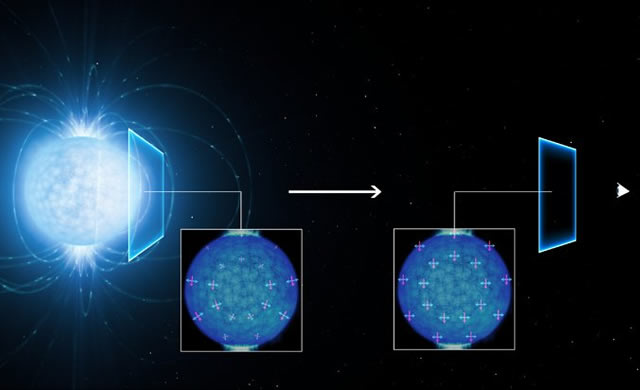
Credits: ESO/L. Calçada
Le osservazioni VLT di una stella di neutroni potrebbero confermare una previsione di ottant’anni fa sulla fisica del vuoto – Studiando con il VLT (Very Large Telescope) dell’ESO la luce emessa da una stella di neutroni strordinariamente densa e fortemente magnetizzata, alcuni astronomi potrebbero aver trovato le prime indicazioni di uno strano effetto quantistico, previsto per la prima volta negli anni ’30 del secolo scorso. La polarizzazione della luce osservata suggerisce che lo spazio vuoto intorno alla stella di neutroni subisca un effetto quantistico noto come birifrangenza del vuoto.
Un’equipe, condotta da Roberto Mignani dell’INAF-IASF di Milano (Italia) e dell’Universita di Zielona Gora (Polonia), ha sfruttato il VLT (Very Large Telescope) dell’ESO all’Osservatorio del Paranal in Cile per osservare la stella di neutroni RX J1856.5-3754, a circa 400 anni luce dalla Terra. Pur essendo tra le più vicine stelle di neutroni, la sua luce è così debole che gli astronomi hanno potuto osservare la stella in luce visibile solo con lo strumento FORS2 installato sul VLT, al limite delle possibilità tecnologiche attuali dei telescopi. Le stelle di neutroni sono i resti molto densi di stelle massicce – almeno 10 volte più massicce del Sole – esplose come supernove al termine della loro vita. Hanno anche un campo magnetico estremo, miliardi di volte più forte di quello del Sole, che permea la loro superficie esterna e i dintorni. Questi campi sono così forti che influenzano anche le proprietà dello spazio vuoto intorno alla stella. Di solito si pensa al vuoto come a uno spazio che non contiene proprio niente e che la luce può attraversare senza esserne modificata. Ma nella teoria elettrodinamica quantistica (QED), la teoria quantistica che descrive l’interazione tra i fotoni di luce e le particelle cariche, come per esempio gli elettroni, lo spazio è pieno di particelle virtuali che appaiono e svaniscono in continuazione. Campi magnetici molto potenti possono modificare questo spazio così che possa influenzare la polarizzazione della luce che lo attraversa. Mignani spiega: “Secondo la QED, un vuoto fortemente magnetizzato si comporta come un prisma per quanto riguarda la propagazione della luce, un effetto noto come birifrangenza del vuoto”. Tra le molte previsioni della QED, la birifrangenza del vuoto non aveva finora una dimostrazione sperimentale diretta. I vari tentativi di rivelarla in laboratorio non sono ancora stati coronati da successo, nonostante siano trascorsi ormai 80 anni dal lavoro di Werner Heisenberg (quello del principio di indeterminazione) e Hans Heinrich Euler che la prevedeva. “Questo effetto può essere rivelato solo in presenza di campi magnetici veramente potenti, come quelli che circondano le stelle di neutroni. Questo dimostra, ancora una volta, che le stelle di neutroni sono laboratori preziosi in cui studiare le leggi fondamentali della natura,” aggiunge Roberto Turolla (Università di Padova, Italia).
Fonte/Leggi tutto → ESO.org
VLT observations of neutron star may confirm 80-year-old prediction about the vacuum – By studying the light emitted from an extraordinarily dense and strongly magnetised neutron star using ESO’s Very Large Telescope, astronomers may have found the first observational indications of a strange quantum effect, first predicted in the 1930s. The polarisation of the observed light suggests that the empty space around the neutron star is subject to a quantum effect known as vacuum birefringence.
A team led by Roberto Mignani from INAF Milan (Italy) and from the University of Zielona Gora (Poland), used ESO’s Very Large Telescope (VLT) at the Paranal Observatory in Chile to observe the neutron star RX J1856.5-3754, about 400 light-years from Earth. Despite being amongst the closest neutron stars, its extreme dimness meant the astronomers could only observe the star with visible light using the FORS2 instrument on the VLT, at the limits of current telescope technology. Neutron stars are the very dense remnant cores of massive stars — at least 10 times more massive than our Sun — that have exploded as supernovae at the ends of their lives. They also have extreme magnetic fields, billions of times stronger than that of the Sun, that permeate their outer surface and surroundings. These fields are so strong that they even affect the properties of the empty space around the star. Normally a vacuum is thought of as completely empty, and light can travel through it without being changed. But in quantum electrodynamics (QED), the quantum theory describing the interaction between photons and charged particles such as electrons, space is full of virtual particles that appear and vanish all the time. Very strong magnetic fields can modify this space so that it affects the polarisation of light passing through it. Mignani explains: “According to QED, a highly magnetised vacuum behaves as a prism for the propagation of light, an effect known as vacuum birefringence.” Among the many predictions of QED, however, vacuum birefringence so far lacked a direct experimental demonstration. Attempts to detect it in the laboratory have not yet succeeded in the 80 years since it was predicted in a paper by Werner Heisenberg (of uncertainty principle fame) and Hans Heinrich Euler. “This effect can be detected only in the presence of enormously strong magnetic fields, such as those around neutron stars. This shows, once more, that neutron stars are invaluable laboratories in which to study the fundamental laws of nature.” says Roberto Turolla (University of Padua, Italy).
Source/Continue reading → ESO.org





















